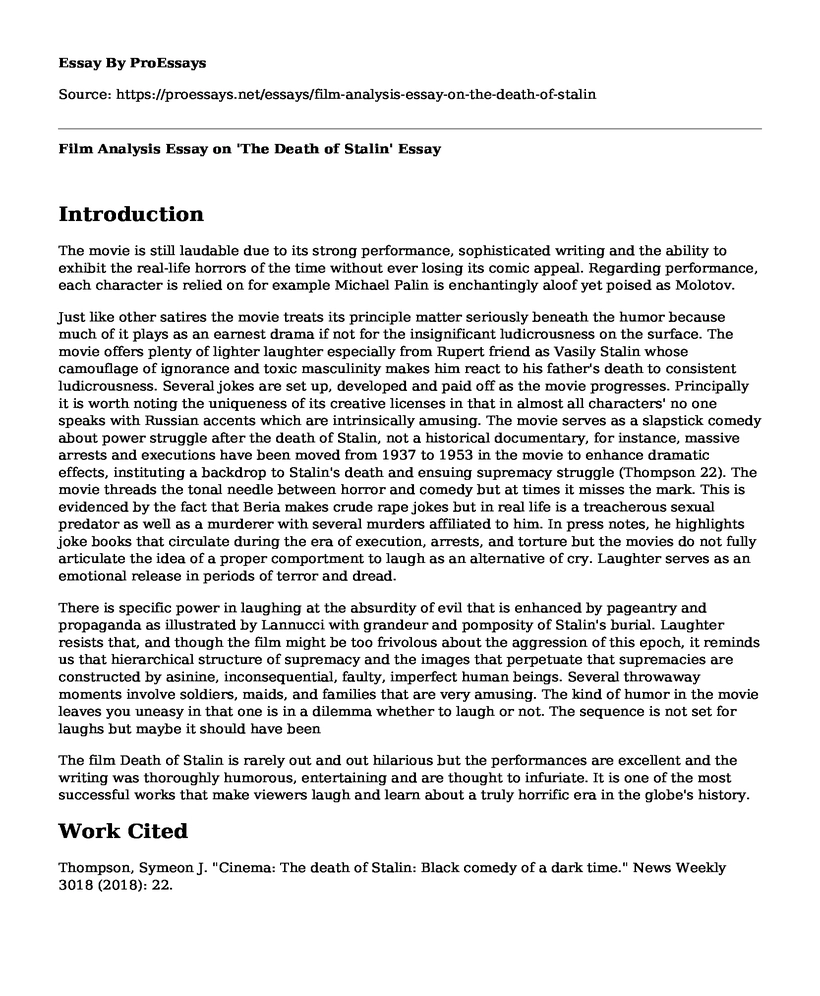Introduction
The movie is still laudable due to its strong performance, sophisticated writing and the ability to exhibit the real-life horrors of the time without ever losing its comic appeal. Regarding performance, each character is relied on for example Michael Palin is enchantingly aloof yet poised as Molotov.
Just like other satires the movie treats its principle matter seriously beneath the humor because much of it plays as an earnest drama if not for the insignificant ludicrousness on the surface. The movie offers plenty of lighter laughter especially from Rupert friend as Vasily Stalin whose camouflage of ignorance and toxic masculinity makes him react to his father's death to consistent ludicrousness. Several jokes are set up, developed and paid off as the movie progresses. Principally it is worth noting the uniqueness of its creative licenses in that in almost all characters' no one speaks with Russian accents which are intrinsically amusing. The movie serves as a slapstick comedy about power struggle after the death of Stalin, not a historical documentary, for instance, massive arrests and executions have been moved from 1937 to 1953 in the movie to enhance dramatic effects, instituting a backdrop to Stalin's death and ensuing supremacy struggle (Thompson 22). The movie threads the tonal needle between horror and comedy but at times it misses the mark. This is evidenced by the fact that Beria makes crude rape jokes but in real life is a treacherous sexual predator as well as a murderer with several murders affiliated to him. In press notes, he highlights joke books that circulate during the era of execution, arrests, and torture but the movies do not fully articulate the idea of a proper comportment to laugh as an alternative of cry. Laughter serves as an emotional release in periods of terror and dread.
There is specific power in laughing at the absurdity of evil that is enhanced by pageantry and propaganda as illustrated by Lannucci with grandeur and pomposity of Stalin's burial. Laughter resists that, and though the film might be too frivolous about the aggression of this epoch, it reminds us that hierarchical structure of supremacy and the images that perpetuate that supremacies are constructed by asinine, inconsequential, faulty, imperfect human beings. Several throwaway moments involve soldiers, maids, and families that are very amusing. The kind of humor in the movie leaves you uneasy in that one is in a dilemma whether to laugh or not. The sequence is not set for laughs but maybe it should have been
The film Death of Stalin is rarely out and out hilarious but the performances are excellent and the writing was thoroughly humorous, entertaining and are thought to infuriate. It is one of the most successful works that make viewers laugh and learn about a truly horrific era in the globe's history.
Work Cited
Thompson, Symeon J. "Cinema: The death of Stalin: Black comedy of a dark time." News Weekly 3018 (2018): 22.
Cite this page
Film Analysis Essay on 'The Death of Stalin'. (2022, Oct 14). Retrieved from https://proessays.net/essays/film-analysis-essay-on-the-death-of-stalin
If you are the original author of this essay and no longer wish to have it published on the ProEssays website, please click below to request its removal:
- Art Work Details and Description: Mona Lisa
- The Relationship Between Tom and Summer: 500 Days of Summer Essay
- Creating Awareness About Immunizations Paper Example
- Polynesian/Micronesian Body Art: Tattoos as Gifts From Gods - Research Paper
- Article Analysis Essay on Understanding a Photograph
- Awe-Inspiring Djembe Drum: The Best Instrument of West Africa - Essay Sample
- Paper Example on Adaptations: A Comprehensive Anthology of Short Stories and Films







